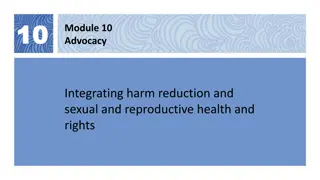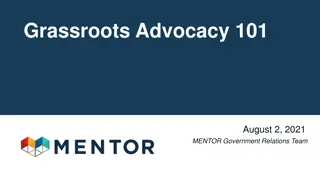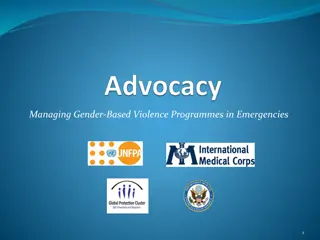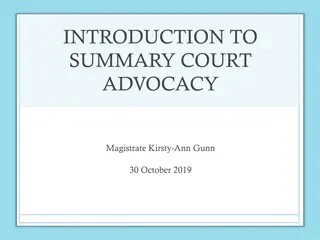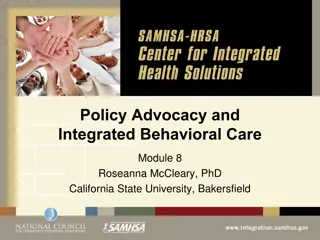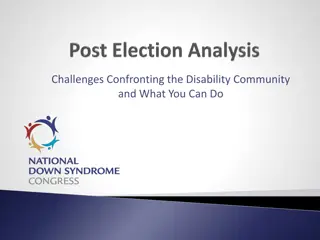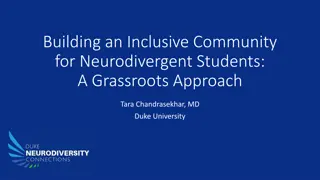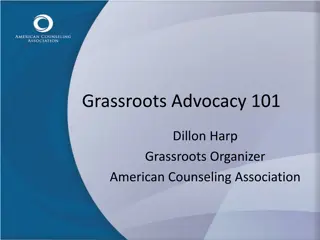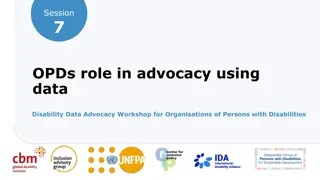Importance of Grassroots Advocacy in Community Support Programs
Grassroots advocacy, led by organizations like LaCAN, plays a crucial role in advocating for community and family support programs. Through initiatives like Act 378 and Act 481, LaCAN has successfully enabled thousands of individuals to access waivers, funds, and supports for persons with developmental disabilities. Guided by principles promoting family relationships and individual rights, their efforts have led to the closure of developmental centers and prioritized home and community-based services. Louisiana's ranking first in per capita ICFs/DD residents highlights the impact of such advocacy on transforming care systems towards more inclusive and person-centered approaches.
Download Presentation

Please find below an Image/Link to download the presentation.
The content on the website is provided AS IS for your information and personal use only. It may not be sold, licensed, or shared on other websites without obtaining consent from the author.If you encounter any issues during the download, it is possible that the publisher has removed the file from their server.
You are allowed to download the files provided on this website for personal or commercial use, subject to the condition that they are used lawfully. All files are the property of their respective owners.
The content on the website is provided AS IS for your information and personal use only. It may not be sold, licensed, or shared on other websites without obtaining consent from the author.
E N D
Presentation Transcript
Councils Grassroots Advocacy What is it and Why is it Important?
LaCAN Grassroots Advocacy Network 10 Regional Teams Advocates for Community and Family Supports
LaCAN Advocacy Results Community and Family Support System (1989, Act 378) 12,000people with waiver slots 2,000receive Flexible Family Fund 3,000receive state funded supports in their own homes
LaCAN is also responsible for Act 481 of 2007 which established the NOW Trust Fund creating a funding source for NOW slots
GUIDING PRINCIPLES Children, regardless of the severity of their disability, need families and enduring relationships with adults in a nurturing home environment. As with all children, children with developmental disabilities need families and family relationships to develop to their fullest potential.
GUIDING PRINCIPLES Contd. Adults with developmental disabilities should be afforded the opportunity to make decisions for themselves and to live in typical homes and communities where they can exercise their full rights and responsibilities as citizens.
State of the State Home and Community-Based Services
Developmental Centers From 9 to 1 in 7 years Closed Privatized Northlake Northwest Acadiana Leesville Northeast Bayou Columbia Metropolitan Pinecrest census at 399
Louisiana Ranks First! Louisiana has the highest number of people per capita living in ICFs/DD in the country.* 107of every 100,000 Louisianans live in an ICF/DD 28per 100,000 is the national average! * As of June 30, 2010 MFP 3
Community and Family Supports Waivers Individual and Family Support Flexible Family Funds
New Opportunities Waiver (NOW) Provides comprehensive supports for people with developmental disabilities to live independentlyor with their families NOW Recipients receive services based on need Most cost effective and better quality of lifethan congregate care
New Opportunities Waiver vs. Residential Costs Average annual costs: New: $45,149 Current: $52,310 NOW Recipient Resident of ICF/DD: (1-8 bed) (33+ bed) $58,035- $73,109 $47,486 - $58,914
New Opportunities Waiver 9,600+ Waiver waiting list: Average length of wait for NOW: NOW slots currently funded: NOW slots cut by legislature last year: 8+ years 8,664 168
Flexible Family Fund Resources cover extraordinary costs for families of children with the most severe disabilities 1,961 6,628 Families Supported (FY12): Waiting List: State General Fund Program Program is in danger of elimination!
Individual/Family Support Critical lifeline of support Avoids out-of-home placement Safety net as families of individuals with extreme needs wait for other services Flexible and immediate access No menu of services Program has been reduced drastically in some regions of the state due to budget cuts. It is in danger of additional cuts!
It Matters Where You Live Individuals/Families across the state do not have access to the same level of Individual and Family Support Budget cuts have disproportionately affected districts and authorities Individual and Family Support has been drastically reduced in many areas of the state
2013 per Capita Total Budget by Human Services Districts and Authorities $90.00 Other Funding $80.00 State General Fund $70.00 $60.00 $50.00 $40.00 $30.00 $20.00 $10.00 $-
Individual and Family Supports Budgets March 2005 August 2012 Percentage Change Change MHSD (1) CAHSD (2) Region 3 / SCHSA* Region 4 / AAHSD* Region 5 Region 6 Region 7 Region 8 FPHSA (9) JPHSA (10) $ 1,298,137 $ 1,057,601 $ 751,050 $ 1,131,824 $ 503,135 $ 653,219 $ 805,739 $ 789,444 $ 762,462 $ 1,500,000* $ 1,054,495 $ 440,974 $ 674,741 $ 579,082* $ 494,808 $ 632,040 $ 835,506 $ 756,600 $ 261,067 $ 475,832 $ (243,642) $ (616,627) $ (76,309) $ (552,742) $ (8,327) $ (21,179) $ 29,767 $ (32,844) $ (501,395) $ (1,024,168) -19% -58% -10% -49% -2% -3% 4% -4% -66% -68% Districts and Authorities OCDD Regional Offices $ 6,501,074 $ 3,486,191 $ (1,990,715) -46% $ 2,751,537 $ 2,718,954 $ (32,583) -1%
Per Capita Individual and Family Support Budgets by Region (SFY13) $3.00 $2.50 IFS Budget per capita $2.00 $1.50 $1.00 $0.50 $-
Percent of Population Served (SFY 2012) Individual and Family Support by Region 0.12% Percent of Population Served 0.10% 0.08% 0.06% 0.04% 0.02% 0.00%
Shift to Local Control By July 1, 2013 decentralization will be completed in all regions All remaining regions will become districts/authorities
Employment Services Since 2009 Louisiana has given up almost $89 million in federal Vocational Rehabilitation funding Over $18.4 million for FY12 alone 2,821individuals on waiting list Limited to those with the most significant disabilities
La. Rehabilitation Services Match is nearly a $4 to $1 For every dollar the state invests in Vocational Rehabilitation services, there is an estimated $9 return to Louisiana Other states get funds Louisiana does not use
LaCANs 2013 Legislative Agenda 368 NOW Slots: End the Wait! Protect & Restore Funding for Individual and Family Support Protect Flexible Family Funds Access Full Vocational Rehabilitation Grant Funds
LaTEACH (Louisiana Together Educating All Children) A statewide grassroots advocacy network created for the purpose of systems change. Modeled after LaCAN in 2004 Over 1,300 members strong!
9 Regional Teams Throughout Louisiana
LaTEACHs Mission LaTEACH promotes appropriate, inclusive education for all students. We work to make parents, educators, the general public, and state leadership informed and supportive of research based and effective practices being used appropriately for each student.
LaTEACH Advocacy Results Act 328 of 2011 regulated the use of restraint and seclusion for students with disabilities in Louisiana schools. Louisiana Alternate Assessment 2 (LAA-2) recognized as an exit exam to meet requirements for graduation (2008). Representation on Governor s Commission for High School Redesign
State of the State Education
Parental Options Vouchers to Private Schools Charter Schools Course Choice School enrollment is competitive and no longer based on where a child lives Traditional Public School Systems still serve students based on their geographic residence Parental Options have fragmented responsibility for educating students
Parental Options? In the movement of creating parental options many parents of children with the most significant disabilities are finding themselves with more and more restricted options.
Parental Options are NOT Inclusive Admissions Percentage of Students with Disabilities: Traditional Public Schools 12% Charter Schools 8% Private Schools Services 3%
Charter Schools vs. LEAs Percentage of Charter Schools NOT Serving Students With Significant Disabilities Percentage of Traditional Districts (LEAs) NOT Serving Students With Significant Disabilities Autism 59% 1% Emotional Disturbance 44% 1% Multiple Disabilities 91% 4% Orthopedic Impairment 75% 3% Traumatic Brain Injury 84% 20% Visual Impairment 84% 16% Data from 2009 Special Education Profile (most recent data available).
School Accountability System Dis-incentivizes Inclusion School performance scores result in highest of stakes school takeover Schools have high incentive to not include students who: Tend not to produce high academic scores Do not make enough academic progress Require more than typical amount of support and use of resources Result: More magnet programs, selective recruiting and counseling out students
Charter School Law Intent: Serve At-Risk Students The intent of the Charter School Law is to serve at-risk students including students with disabilities Unfortunately there are no standards that require charter schools to serve a representative portion of students with disabilities
Segregated Schools/Settings Schools serving specific disabilities Charter Schools serving select populations Draft legislation would further expand segregation La. Special Education Center Transitioned overage residents out Advertised to fill the beds
LaTEACH s 2013 Advocacy Agenda Guarantee Equal Access and Services Prevent the Formation of Segregated Schools
Legislative Visits Regional Teams What is the DD Council Council s Legislative Agenda Fact Sheets





